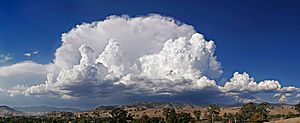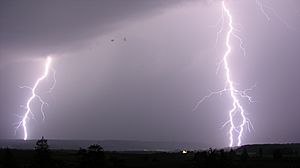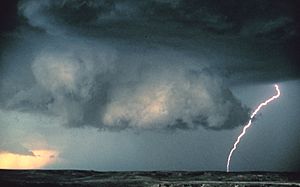Thunder facts for kids


Thunder is the loud sound you hear after lightning flashes. It can sound like a long, low rumble or a sudden, sharp crack, depending on how far away the lightning is. When lightning streaks through the air, it heats the air around it super fast. This hot air expands very quickly, creating a powerful wave of sound. This sound wave is what we call thunder, sometimes heard as a "thunderclap."
Contents
What Causes Thunder?
For a long time, people wondered what caused thunder. In the past, some thought lightning created an empty space (a vacuum), and the sound came from that space collapsing.
Today, scientists know that thunder starts with a "shock wave" in the air. This happens because the lightning channel, which is like a super-hot electrical path, heats the air around it to extreme temperatures. Imagine the air getting hotter than the surface of the sun for a tiny moment! This sudden heating makes the air expand outward much faster than sound usually travels. This fast-moving air creates a shock wave, similar to the sound from an explosion or a supersonic jet.
Scientists have studied this using special experiments that copy lightning. Their findings mostly agree with this idea.
What Can Thunder Do?
The shock wave from thunder can be very powerful, especially if you are close to where the lightning strikes. Loud thunder can sometimes cause minor damage to buildings or even hurt people nearby. For example, it can be loud enough to temporarily affect your hearing or, in rare cases, even damage eardrums.
Different Kinds of Thunder Sounds
Scientists have noticed that thunder sounds can be grouped by how loud they are, how long they last, and their pitch (how high or low they sound).
- Claps are loud sounds that last for a short time, usually less than two seconds, and have higher pitches.
- Peals are sounds where the loudness and pitch change as you hear them.
- Rolls are a mix of different loudnesses and pitches, sounding a bit uneven.
- Rumbles are less loud, last longer (sometimes more than 30 seconds), and have a low pitch.
Sometimes, thunder sounds much louder than expected from a certain distance. This can happen during a "temperature inversion." This is when the air near the ground is cooler than the air higher up. In these conditions, sound energy doesn't spread out as much vertically. Instead, it stays closer to the ground, making the thunder seem much louder.
Lightning that goes from a cloud to the ground (called CG lightning) often has more than one "return stroke." These later strokes usually create louder thunder than the first one.
How We Hear Thunder
You always see lightning before you hear thunder. This is because light travels much, much faster than sound. Light travels almost instantly, but sound travels much slower.
The speed of sound in dry air is about 343 meters per second (1,125 feet per second) at 20 degrees Celsius (68 degrees Fahrenheit). This means sound travels about 1 kilometer (0.6 miles) in 3 seconds.
You can use this to estimate how far away a lightning strike is:
- Count the seconds between seeing the lightning flash and hearing the thunder.
- Divide the number of seconds by 3 to get the distance in kilometers.
- Or, divide the number of seconds by 5 to get the distance in miles.
If you see a very bright flash of lightning and hear a loud, sharp "crack" of thunder almost at the same time, it means the lightning strike was very close to you!
When lightning is very close, you might first hear a clicking or tearing sound, then a loud "cannon shot" or crack, followed by a continuous rumbling. The first sounds come from the very beginning parts of the lightning bolt, and then the louder sounds come from the main part of the lightning strike.
Fun Facts About Thunder
- The scientific study of thunder is called brontology.
- If someone has an extreme fear of thunder, it's called brontophobia.
- The name of the Norse god Thor, who was known for his hammer and storms, comes from an old word for thunder.
- Close to where lightning strikes, the sound of thunder can be incredibly loud, sometimes even louder than a jet engine!
- Ancient Greek thinkers believed thunder was caused by natural things, like wind hitting clouds or air moving inside clouds.
- The Roman philosopher Lucretius thought thunder came from hail hitting together inside clouds.
See also
 In Spanish: Trueno para niños
In Spanish: Trueno para niños
- Brontophobia (fear of thunder)
- Castle Thunder sound effect
- Lightning
- List of thunder gods
- Mistpouffers
- Sonic boom
- Thunderbolt
- Thunderstorm


